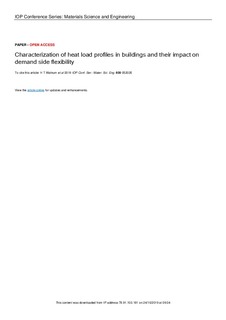| dc.contributor.author | Walnum, Harald Taxt | |
| dc.contributor.author | Alonso, Maria Justo | |
| dc.contributor.author | Clauß, John | |
| dc.contributor.author | Lindberg, Karen Byskov | |
| dc.date.accessioned | 2019-10-25T14:13:40Z | |
| dc.date.available | 2019-10-25T14:13:40Z | |
| dc.date.created | 2019-10-24T10:38:36Z | |
| dc.date.issued | 2019 | |
| dc.identifier.issn | 1757-8981 | |
| dc.identifier.uri | http://hdl.handle.net/11250/2624552 | |
| dc.description.abstract | A data set of heat load measurements for 197 buildings from different building categories (apartment blocks, hotels, nursing homes, offices and schools), have been analysed to evaluate the potential for peak shaving. A moving average filter is applied to investigate how smoothening of the load profiles can reduce the peak loads. It is shown that for short term peak shaving, apartment blocks and hotels have the highest potential (around 8% for a two hour period), while for longer term peak shaving, the results are more even for all the building categories. Schools stand out, with a large difference in heat consumption between inside and outside opening hours, leading to a large flexibility potential on daily basis, but this would require a large amount of stored energy. As it is difficult to control, and thereby reduce the peaks for unknown loads, a prediction model is applied to the data, to analyse the predictability. It is shown that the peak shaving potential is reduced 90-30 % when analysing only the predictable loads. The biggest difference is in the short-term potential for apartment blocks and hotels, while difference is smaller in the long-term (24-hour) peak shaving potential. | nb_NO |
| dc.language.iso | eng | nb_NO |
| dc.publisher | IOP Conference Science | nb_NO |
| dc.relation.ispartof | IAQVEC 2019 | |
| dc.rights | CC BY 3.0 | * |
| dc.rights.uri | https://creativecommons.org/licenses/by/3.0/ | * |
| dc.title | Characterization of heat load profiles in buildings and their impact on demand side flexibility | nb_NO |
| dc.type | Journal article | nb_NO |
| dc.type | Peer reviewed | nb_NO |
| dc.description.version | publishedVersion | nb_NO |
| dc.rights.holder | © The authors | nb_NO |
| dc.subject.nsi | VDP::Teknologi: 500 | nb_NO |
| dc.source.volume | 609 | nb_NO |
| dc.source.journal | IOP Conference Series: Materials Science and Engineering | nb_NO |
| dc.identifier.doi | 10.1088/1757-899X/609/5/052035 | |
| dc.identifier.cristin | 1740092 | |
| dc.relation.project | Norges forskningsråd: 281000 | nb_NO |
| cristin.unitcode | 7401,30,20,0 | |
| cristin.unitcode | 7401,30,40,0 | |
| cristin.unitname | Bygninger og installasjoner | |
| cristin.unitname | Arkitektur, byggematerialer og konstruksjoner | |
| cristin.ispublished | true | |
| cristin.fulltext | original | |
| cristin.qualitycode | 1 | |

